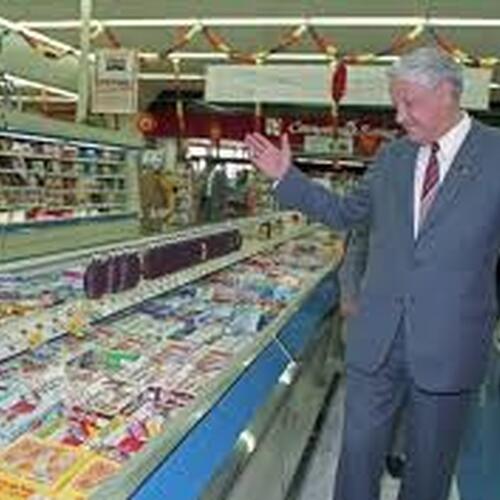Perestroika
This photo captures Boris Yeltsin, the future president of Russia, visibly shocked during his visit to an American grocery store in 1989. The image shows Yeltsin examining the well-stocked shelves filled with an abundance of products, a stark contrast to the shortages and limited consumer goods available in the Soviet Union at the time. This moment reportedly left a deep impression on Yeltsin, highlighting the economic disparities between the United States and the Soviet Union and reinforcing his belief in the need for significant reforms to modernize Russia’s economy. The photo has since become symbolic of the profound impact of firsthand exposure to Western capitalism on Soviet leaders during the final years of the Cold War.
In a 1984 interview, British Prime Minister Margaret Thatcher shared her views on Mikhail Gorbachev, then a rising figure in Soviet politics. Thatcher, known for her staunch anti-communist stance, described Gorbachev as a leader with whom the West could potentially engage in meaningful dialogue. She famously remarked that he was someone she 'could do business with,' reflecting her cautious optimism about his pragmatic approach and reformist tendencies. This assessment came before Gorbachev became General Secretary of the Communist Party of the Soviet Union in 1985 and initiated his landmark policies of glasnost (openness) and perestroika (restructuring), which would profoundly impact East-West relations and the eventual end of the Cold War.
On March 30, 1987, in Moscow, British Prime Minister Margaret Thatcher and Soviet leader Mikhail Gorbachev held a candid discussion on world affairs and the outlook of their respective nations. During the conversation, Thatcher articulated her grievances with the USSR, particularly concerning its human rights record and global military activities, making clear her critiques of Soviet policies.
For his part, Gorbachev listened attentively and began to understand that the West’s perception of the USSR was more negative than he had anticipated. This realization underscored the deep mistrust that characterized East-West relations and highlighted the challenges Gorbachev faced in improving the Soviet Union’s international standing. The dialogue reflected both leaders’ determination to engage in frank discussions, paving the way for greater transparency and cooperation during a pivotal period in Cold War history.
On July 6, 1989, in a historic speech to the Council of Europe in Strasbourg, Soviet leader Mikhail Gorbachev addressed the departure of the USSR from the Brezhnev Doctrine, which had previously justified Soviet intervention in Eastern Bloc countries to preserve communist rule. Gorbachev elaborated that the Soviet Union would no longer interfere in the internal affairs of Eastern European countries, marking a dramatic shift in Soviet foreign policy. He explicitly acknowledged that the USSR would not intervene as it had in the past, citing events like the Soviet invasion of Hungary in 1956. This statement was a key moment in the process of glasnost and perestroika, signaling Gorbachev’s commitment to reducing Soviet control over Eastern Europe and allowing for greater political autonomy within the Warsaw Pact nations. The speech was a turning point in the Cold War, signaling a new era of Soviet non-intervention and contributing to the eventual collapse of communist regimes in Eastern Europe.
Perestroika and Glasnost
Written in 1987 and discusses the departure of Gorbachev from the failed policies of Brezhnev. Underlies the arguments against such a centralized system as the catalyst for the economic reforms and the appeal to democracy and collective leadership as more “socialist” than the status quo from the perspective of Gorbachev.
Uskorenie, Glasnost’ and Perestroika: The Pattern of Reform under Gorbachev
Written in 1988 about the kinds of political and economic reform brought under Gorbachev. Discusses the future outlook and uncertainty of these reforms while also highlighting the general pattern of the reforms.
